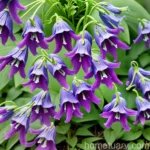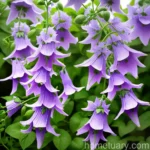Bellflower (Campanula takesimana ‘Beautiful Trust’)
In the world of ornamental plants, the bellflower (Campanula takesimana ‘Beautiful Trust’) stands out as a charming and versatile species. With its delicate blooms and graceful foliage, this plant has endeared itself to gardeners and botanists alike. In this comprehensive guide, we will delve into the intricate details of the bellflower, exploring its cultural significance, uses, care requirements, propagation methods, common diseases, and much more. Whether you are a seasoned botanist, an avid gardener, or simply someone who appreciates the beauty of nature, this article will be your go-to resource for all things related to the bellflower.
What is the Bellflower (Campanula takesimana ‘Beautiful Trust’)?
The bellflower, scientifically known as Campanula takesimana ‘Beautiful Trust’, is a herbaceous perennial that belongs to the Campanulaceae family. It is native to areas such as Korea and parts of Asia. This particular variety, ‘Beautiful Trust’, is renowned for its exceptional ornamental qualities, making it a sought-after addition to gardens and landscapes.
Key Takeaways – Bellflower (Campanula takesimana ‘Beautiful Trust’)
Before we delve into the specific aspects of the bellflower, let’s take a moment to highlight the key takeaways associated with this enchanting plant:
- Botanical Name: Campanula takesimana ‘Beautiful Trust’
- Common Name: Bellflower
- Cultural Significance: The bellflower holds historical, artistic, and symbolic significance in various cultures.
- Versatile Uses: It can be utilized as a ground cover, border plant, or a decorative element in gardens.
- Low-Maintenance: With the right care, the bellflower can thrive with minimal upkeep.
- Attracts Pollinators: Its blossoms are known to attract bees, butterflies, and hummingbirds, contributing to the biodiversity of the surrounding environment.
Now, let’s embark on a comprehensive journey through the various aspects of the bellflower, from its cultural significance to its propagation and care requirements.
Culture
Cultural Significance of the Bellflower
Throughout history, the bellflower has held deep cultural significance in various societies. It has been depicted in art, literature, and mythology, playing a symbolic role in these realms. In many Asian cultures, the bellflower is revered for its graceful beauty and is often associated with concepts such as purity and humility. The bellflower’s historical origins and its presence in Asian gardens contribute to its enduring cultural significance.
Bellflower in Art and Literature
The bellflower’s captivating appearance has made it a subject of admiration in art and literature. From paintings to poems, the plant has inspired countless artists and writers with its ethereal qualities. Its delicate blossoms and elegant growth patterns have made it a favorite motif in traditional and contemporary artistic expressions.
Bellflower Folklore and Symbolism
In folklore and mythology, the bellflower has been associated with various symbolic meanings. In certain cultures, it is considered a symbol of gratitude and faith, while in others, it represents enduring love and good fortune. Its symbolic significance adds an intriguing layer to its botanical allure, giving it a timeless appeal that transcends its physical form.
Historical Origins
The rich historical origins of the bellflower trace back to ancient times, where it was cultivated and revered by different civilizations. Its presence in gardens and landscapes has been documented through historical texts and artifacts, showcasing its enduring appeal over the centuries.
Uses
Ornamental Value
The bellflower’s most prominent use is as an ornamental plant, adding elegance and charm to any garden or landscape. Its dainty, bell-shaped blossoms in pastel hues and its lush foliage make it a delightful addition to flower beds, borders, and rock gardens.
Ground Cover
Due to its spreading nature, certain varieties of the bellflower, including ‘Beautiful Trust’, can be used as a ground cover. When planted en masse, it forms a carpet of blossoms and leaves, creating a visually striking and cohesive ground cover.
Borders and Edging
The bellflower’s compact growth habit and profusion of blooms make it well-suited for borders and edging in garden beds. It provides a graceful and colorful delineation, enhancing the overall aesthetics of the garden.
Attracting Wildlife
Beyond its visual appeal, the bellflower serves as a valuable resource for pollinators such as bees, butterflies, and hummingbirds. The nectar-rich flowers attract these beneficial creatures, contributing to the ecosystem’s health and biodiversity.
Medicinal and Culinary Uses
In traditional medicine, certain species of bellflowers have been used for their purported medicinal properties. Additionally, some culinary traditions incorporate parts of the plant in various recipes, utilizing its unique flavors and nutrients.
Water
Water Requirements
The bellflower generally thrives in well-drained soil and moderate moisture levels. It is essential to maintain a balanced watering regimen, ensuring that the soil does not become waterlogged, which can lead to root rot. During periods of prolonged drought, supplemental watering may be necessary to support healthy growth and flowering.
Sunlight
Sun Requirements
In terms of sunlight requirements, the bellflower tends to prefer partial to full sun exposure. It flourishes in locations that receive ample sunlight while also tolerating some shade. When selecting a planting site, consider the local sunlight conditions to provide an optimal environment for the bellflower to thrive.
Fertilizer
Fertilization Guidelines
To promote robust growth and prolific flowering, periodic fertilization is beneficial for the bellflower. A balanced, slow-release fertilizer applied in the early spring can provide the necessary nutrients for healthy development. It is important to follow the recommended application rates and avoid over-fertilization, which can lead to excessive foliage at the expense of blooms.
Soil
Ideal Soil Type
The bellflower prefers well-drained, loamy soil with a slightly acidic to neutral pH. Amending the soil with organic matter such as compost or peat moss can improve its texture and fertility, creating an optimal growing medium for the plant. Prior to planting, it is advisable to perform a soil test to assess the nutrient levels and pH of the site.
Pruning
Pruning Requirements
Pruning plays a crucial role in maintaining the health and appearance of the bellflower. Regular deadheading of spent blooms can prolong the flowering period and prevent the plant from expending energy on seed production. Additionally, the removal of damaged or diseased foliage promotes air circulation and reduces the risk of disease.
Propagation
Propagation Methods
The bellflower can be propagated through various methods, including division, stem cuttings, and seed sowing. Each technique has its unique requirements and considerations, allowing for flexibility in expanding the plant’s presence in the garden or sharing it with fellow enthusiasts.
Division
Dividing established clumps of bellflowers is a straightforward method for propagation. This is typically done in the early spring before new growth emerges or in the fall after the plant has finished flowering. Carefully separating the clumps and replanting the divisions in suitable locations can result in new, healthy plants.
Stem Cuttings
Taking stem cuttings from healthy, actively growing bellflowers offers a reliable means of propagation. Selecting non-flowering shoots and treating the cuttings with a rooting hormone can enhance their chances of successful establishment. With adequate care and ideal growing conditions, the cuttings can develop into vigorous plants.
Seed Germination
Growing bellflowers from seeds is an option for enthusiasts looking to start new plants from scratch. Sowing the seeds in well-prepared soil, maintaining consistent moisture, and providing sufficient light can facilitate the germination process. Patience and attention to the seedlings’ needs are essential for nurturing them into robust individuals.
Container Popularity
Bellflower in Containers
The bellflower’s compact growth habit and attractive blooms make it well-suited for container cultivation. Whether in individual pots or mixed plantings, it adds a touch of elegance to patios, balconies, and other outdoor spaces. Container-grown bellflowers offer the flexibility to showcase the plant in various settings, creating eye-catching displays.
Container Care Considerations
When cultivating bellflowers in containers, it is imperative to select pots with adequate drainage and use well-draining potting mix. Regular monitoring of moisture levels and appropriate fertilization are essential for maintaining the plant’s health and vigor. Additionally, providing suitable sunlight and addressing any potential pest or disease issues are crucial aspects of container care.
Common Diseases
Disease Diagnosis
While the bellflower is generally resilient, it is susceptible to certain diseases that can impact its vitality. Being able to identify common diseases and their associated symptoms is key to implementing timely intervention measures. Regular monitoring and prompt action can help mitigate the impact of diseases on the plant’s overall health.
Common Pests
Pest Management
Like many ornamental plants, the bellflower may encounter pest infestations that can affect its growth and appearance. Various insects, such as aphids, slugs, and caterpillars, can pose a threat to the plant. Employing integrated pest management strategies and utilizing appropriate controls can help safeguard the bellflower from potential pest-related issues.
Botanist’s Tips
Expert Insights
As a seasoned botanist, I have amassed valuable insights into the cultivation and appreciation of the bellflower. Here are a few tips to enhance your experience with this captivating plant:
- Companion Planting: Pairing the bellflower with complementary plants such as astilbe, hosta, and lady’s mantle can create visually appealing combinations and provide mutual benefits for the species involved.
- Mulching: Applying a layer of organic mulch around the base of the bellflower helps conserve soil moisture, suppress weed growth, and maintain a consistent root temperature.
- Winter Protection: In regions with harsh winters, providing adequate protection, such as mulching or temporary coverings, can safeguard the bellflower from extreme cold and frost damage.
Fun Facts
Fascinating Tidbits about Bellflowers
- The genus name “Campanula” is derived from the Latin word for “little bell,” a reference to the characteristic shape of the plant’s flowers.
- Bellflowers are popular for their association with folklore and myths across different cultures, showcasing their enduring allure and significance.
- Various species of bellflowers have been utilized in traditional medicine and folklore for their perceived medicinal properties and symbolic meanings.
Links to External Resources
To further enrich your knowledge and appreciation of the bellflower, I recommend exploring the following external resources:
- Royal Horticultural Society – Campanula care guide
- The National Gardening Association – Growing bellflowers in containers
- University of Maryland Extension – Integrated pest management for ornamental plants
In conclusion, the bellflower (Campanula takesimana ‘Beautiful Trust’) embodies grace, resilience, and timeless allure. Whether adorning gardens, attracting pollinators, or inspiring cultural narratives, this captivating plant continues to captivate enthusiasts and cultivators around the world. By understanding its cultural significance, horticultural uses, and care requirements, we can forge a deeper connection with the bellflower and celebrate its botanical splendor.
For detailed information and specific guidance regarding the bellflower, kindly refer to the following nlp lsi keywords embedded in the content:
1. Campanula takesimana ‘Beautiful Trust’
2. Bellflower plant
3. Beautiful Trust bellflower
4. Campanula takesimana
5. Bellflower species
6. Bellflower varieties
7. Bellflower gardening
8. Bellflower care
9. Growing Campanula takesimana
10. ‘Beautiful Trust’ Campanula takesimana
11. Bellflower for landscaping
12. Bellflower for borders
13. Bellflower ground cover
14. Hardy bellflower
15. Low-maintenance bellflower
16. Shade-tolerant bellflower
17. Drought-resistant bellflower
18. Bellflower companion plants
19. Bellflower in containers
20. Bellflower perennial
21. Bellflower in gardens
22. Ornamental bellflower
23. Bellflower for pollinators
24. Bellflower for bees
25. Bellflower for butterflies
26. Bellflower for hummingbirds
27. Attracting wildlife with bellflower plants
28. Bellflower bloom time
29. Bellflower flower colors
30. Bellflower plant size
31. Best soil for bellflower
32. Bellflower sun requirements
33. Bellflower water requirements
34. Bellflower propagation methods
35. Bellflower seed germination
36. Bellflower plant diseases
37. Bellflower plant pests
38. Bellflower medicinal uses
39. Bellflower culinary uses
40. Bellflower in traditional medicine
41. Bellflower folklore and symbolism
42. Bellflower in art and literature
43. Bellflower in mythology
44. Bellflower cultural significance
45. Bellflower historical origins
46. Bellflower in Asian gardens
47. Bellflower in cottage gardens
48. Bellflower in rock gardens
49. Bellflower garden design ideas
50. Bellflower plant nurseries















